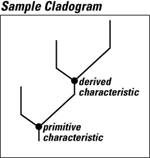The Missing Link
|  |
Student Handout |
Cladogram Basics
In cladistics, similar characteristics that come from a common ancestor are used to divide organisms into groups. A cladogram will begin by grouping organisms based on a characteristic displayed by all the members of the group. Subsequently, the larger group, or clade, will contain increasingly smaller groups (clades) that share the traits of the clades before them, but also exhibit distinct changes as the organism evolves.
The example that follows represents a cladogram.


Characteristics: no (0), yes (1)
1 is eukaryotic
2 is multicellular
3 has segmented body
4 has jaws
5 has limbs
6 has hair
7 has placenta
Source: Science at a Distance—Professor John Blamire
(www.brooklyn.cuny.edu/bc/ahp/CLAS/CLAS.Clad.html)
To make a cladogram, scientists first collect data on
the features of all the organisms they hope to classify. This data is then analyzed to determine which characteristics were present in what could have been a common ancestor and which might have been developed in
later times. Use the following instructions to make a
cladogram for your set of hardware organisms.
Procedure
Make your cladogram on a separate sheet of paper. Lay out your organisms on a work surface. List all the characteristics you see for each object and make a table of all the traits. Which characteristic do all the objects have in
common? This is referred to as a primitive, or original, characteristic. It is of little value in analyzing the
relationships within a group since all members possess this characteristic. Again look at the data to determine common
characteristics that only a portion of the group
has. These are referred to as derived, or advanced,
characteristics. They are usually more advanced
features that were added to the primitive features found earlier. The largest group of these derived
characteristics will be the first to branch from the
main trunk of the cladogram. Name the derived
characteristic and list all the objects that have that characteristic. Your drawing of the cladogram at
this point should look similar to the following:

Look for further characteristics that are common to only a portion of the group and add these to the cladogram until the groups can be sorted no further.
|

